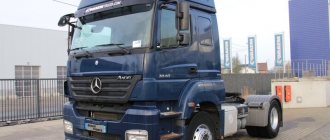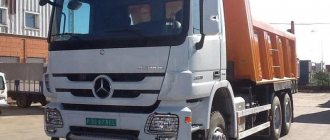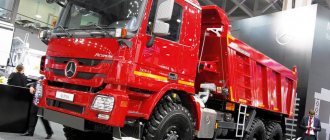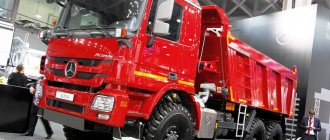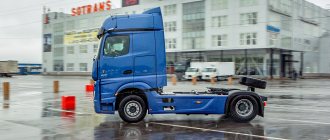Problems and causes
In particular, the following problems arose:
· deterioration in starting, especially in cold and damp weather;
· increase in operating temperature to overheating values;
· interruptions in the operation of cylinders;
· instability of idle speed at low and medium speeds;
· drop in compression and power when driving with a full load;
· increased fuel consumption.
When contacting a specialized service center for servicing Mercedes Benz trucks and diagnosing the engine using professional equipment, the following main causes of problems were identified in the form of:
· formation of a carbon layer on valves, pistons and injectors;
· corrosion of intake system parts exposed to atmospheric moisture condensation;
· reduced permeability of the oil system channels and fuel supply due to their clogging with resinous deposits;
· dilution of engine oil to unacceptable values.
According to the specialist, such manifestations are caused by a number of destructive factors, such as the use of low-quality fuel with a high sulfur content, wear of the exhaust gas recirculation mechanism, and the use of lubricating fluids that do not meet recommended standards and exceed the replacement interval.
Features of operating the OM470 motor
In-line six-cylinder diesel engines OM470 with the asymmetric direct injection Common Rail APCRS system, which are equipped with the 4th generation Mercedes-Benz Actros, are adapted by the manufacturer, Daimler Chrysler, to the Euro 6 eco-standard.
They combine the options of SCR urea neutralization and EGR exhaust recirculation. The exhaust system is equipped with a catalyst-neutralizer paired with a regenerable DPF particulate filter.
On Mercedes-Benz OM 470 engines, the recirculation system also includes a water-gas heat exchanger, which reduces the temperature of the exhaust gases supplied to the cylinders from 150 to 50 °C.
These engines, unlike gasoline engines, operate at lower speeds, which is due to a slower fuel combustion cycle. Therefore, special diesel engine oils are used for them, providing stable viscosity values and the ability to fully lubricate parts at minimum speed.
In addition, such products must have high cleaning properties to quickly dissolve and remove soot. Therefore, any modern diesel oil must include a standard package of detergent and antifriction additives.
The OM 470 engine must be filled with oil that complies with ACEA classification standards E4-99/E6-04/E7-04 and manufacturer approval MB 228.51/235.27 (all-season diesel oils for Mercedes-Benz trucks with turbodiesel).
Vehicle equipment
Standard Equipment
| A91 | Straight front axle beam |
| AL3 | Front axle 7.5 t |
| AM3 | Rear axle H7, 16.0 t, driven gear 300 mm |
| BB8 | Telligent braking system with ABS and ASR |
| BD3 | Brake and electrical connectors with top position |
| Dual-circuit pneumatic braking system | |
| Automatic brake adjustment | |
| Connectors for trailer dual-circuit brake system | |
| Spiral hoses and trailer connection cables | |
| Recoil system | |
| Spiral hoses and trailer connection cables | |
| CL9 | Steering LS6/LS8 |
| Front axle stabilizer | |
| The steering column is height and tilt adjustable, lockable. | |
| Unit brackets on the left side | |
| Multifunction steering wheel | |
| D25 | Cab roof hatch |
| EC6 | Trailer connection connector 15-pin |
| F24 | The rear wall of the cabin is straight |
| FE5 | Electric windows for cab doors |
| FS2 | Driver's mirror with wide viewing angle, heated. |
| FZ7 | Immobilizer with transponder |
| Rear wall of the cabin without window | |
| Mirror with wide viewing angle from the passage side | |
| Rear mirror type with electric drive and heating | |
| Passenger side ramp mirror | |
| central locking | |
| HF2 | Cabin ventilation air filter |
| Cabin heating and ventilation system control | |
| External temperature indicator | |
| Telligent on-board control system | |
| KS4 | Fuel tank 400 l, steel, on the right side |
| Fuel consumption indicator | |
| 6-section rear headlight with reflectors | |
| Headlights with transparent optics (H7) | |
| Breaker for additional direction indicators | |
| MA9 | Engine mounts for rough roads |
| MD4 | Speed limiter 90 km/h |
| MD9 | Cruise control TEMPOMAT |
| MX0 | Engine V6, LA, 335kW / 456hp, 1800 rpm |
| Generator 28V/80A | |
| Fuel preheating system | |
| Engine brake with constant throttle | |
| Protection under the radiator | |
| N55 | Transmission cooling system |
| SF0 | Passenger seat folding |
| SG5 | Driver's seat with suspension, Isringhausen |
| TR6 | Option with gross weight 33.0 t (7.5/13.0/13.0) |
| X57 | Noise reduction measures EU 96/20 |
| XK3 | Engine/transmission warranty 3 years/250,000 km |
| XV6 | Actros 3 |
| Stairs and platform behind the cabin | |
| Tool kit | |
| Z01 | Execution depending on the country of destination |
| ZZ3 | Vehicle for right-hand traffic |
Optional equipment
| AR1 | Final drive ratio i= 5.333 (HL7) |
| B65 | Heated air preparation unit |
| BB6 | Drum brakes on front and rear axles |
| C63 | Steel bumper |
| C69 | Mounting angle for saddles. device, extended |
| CD4 | Stabilizer for the second rear axle, reinforced |
| DD2 | Cab with low roof, internal height 1560 mm |
| EB3 | Batteries 2 X 12V/220 Ah, low maintenance |
| EU1 | CD radio |
| F04 | Cabin L |
| FE6 | Cabin step, movably fixed |
| FJ4 | Driver and passenger rubber floor mats |
| FL3 | Reinforced cab suspension for poor road conditions |
| FL4 | Cabin spring suspension |
| FM2 | Tinted glass, ribbon wind filter. glass |
| FN2 | Comfort front panel |
| FS4 | Sunshade on the driver's door window |
| FX7 | Aerodynamic front mirror |
| G81 | Strengthened clutch |
| GC2 | Gearbox G 240-16/11.7-0.69 |
| GS7 | Telligent II gearshift |
| H03 | Air conditioning in the cabin |
| H04 | Additional cabin thermal insulation |
| H61 | Additional air heater Webasto Air Top 2000 |
| JD3 | Digital tachograph, AETR |
| JK3 | Combination devices with graphic display and econometer |
| JZ1 | Tachograph produced by VDO |
| K40 | Fuel tank lockable |
| K45 | Mesh in the fuel tank neck |
| K81 | Fuel filter with heated water separator |
| KE9 | On-board diagnostics 2 with NOx monitoring |
| KG2 | Muffler with SCR catalyst, medium, stainless steel |
| KH7 | Exhaust direction to the left |
| KI0 | Protection under the fuel tank |
| KP3 | AdBlue tank, 85 l |
| L30 | Protective grilles for headlights |
| L43 | Road train designation sign |
| M62 | Air intake. behind the cabin on top, filter under the cabin |
| M67 | Air pre-cleaning cyclone filter |
| M72 | Protection under the radiator and engine |
| M78 | Engine number stamped |
| M89 | Cold start flare device |
| MK9 | Anti-mosquito net in front of the radiator |
| MO1 | Electromagnet. Behr viscous coupling for fan drive |
| MS5 | Euro 5 engine version using BlueTec |
| MZ7 | Single cylinder compressor with max pressure limiter |
| NH2 | KOM MB 131-2с, from intermediate. gearbox shaft |
| P32 | Three-section rear wings (EU) |
| P80 | Rear wheel fenders for vehicle width 2500 mm |
| QF3 | Rear springs 15.0 t, rigid |
| QJ9 | Fifth wheel coupling Jost 38-С1, 2", H=190mm |
| QM8 | Mounting plate 40 mm for fifth wheel clutch. device 36 t |
| QY1 | Front springs 9.0 t, rigid |
| R04 | Protective caps for wheel nuts |
| R10 | Wheels, 9.00×22.5, reinforced |
| R60 | Temporary spare wheel mount |
| R87 | Spare wheel disc |
| SM5 | The lower berth is comfortable, adjustable |
| XS1 | Instructions in Russian |
| Y28 | 2 wheel chocks |
| Y34 | Tire inflation hose, 10 m |
| Y42 | Telescopic jack, 12 t |
| Y44 | Warning triangle (triangle) |
| Y69 | Hydraulic cab lift, lower temp. -25 °C |
| YA8 | Option without front lower fairing |
Oil for filling into a truck tractor
For the D-OM470LA.6-1 engine, the ideal product that meets the entire set of Euro 6 requirements is the fully synthetic engine oil Top Tec Truck 4050 10W40 designed for powerful diesel trucks. Developed based on the synthesis of basic low-ash components with the introduction of a standard package of innovative additives, it provides an effective combination of anti-friction and detergent properties even under extreme loads. The recommended replacement interval is 40-50 thousand km.
Recommended Additional Products
1. Liqui Moly Oilsystem Spulung High Performance Diesel is a detergent for radical cleaning of the oil system, used to flush the engine before adding new oil. Ensures the cleanliness of oil-conducting lines by dissolving and then removing resinous deposits and sludge from them. Prevents coking of piston rings, restores pressure in the lubrication system to the required values.
2. Truck Series Complete Diesel System Cleaner – cleaner for diesel engine injection systems. It is used for preventive purposes to remove carbon deposits and varnish deposits, ensuring the cleanliness of metal surfaces. Increases the cetane number of fuel. Minimizes the amount of harmful emissions.
3. Liqui Moly Multifunktionsadditiv Diesel - a multifunctional diesel additive that prevents corrosion, cleans injectors and increases the cetane number of fuel. Minimizes engine noise and ensures easy starting even in adverse weather conditions.
4. Liqui Moly Super Diesel Additiv – a complex additive that improves the lubrication properties and ignition of fuel, including those with low sulfur content. For modern diesel engines with common-rail function, where injection is carried out under high pressure. Increases cetane number. Can be used as a preservative.
Vehicle characteristics
| Wheelbase: | 3300 mm |
| Permissible gross weight: | 33000 kg |
| Wheel formula: | 6×4 |
| Cabin type: | L-cab with low roof |
| Engine power: | 335 kW (456 hp) |
| Basic chassis model: | 93416112 |
| Carrying capacity/load on SSU: | 22901 kg |
| Location of controls: | left |
| Fifth wheel offset: | 965 mm |
Mercedes-Benz Actros MP3: daily extreme timber truck
We all know from school that paper is made from wood at a special plant, but many have never thought about how wood gets from the forest to the production workshop. The average person is reminded of this only by the heavy timber trucks that are periodically encountered on public roads. We ourselves decided to try how it works on such transport, and went to the Komi Republic, to the largest timber processing plant in Russia, “Mondi Syktyvkar LPK”
Production at the plant is continuous, log-truck trains - this is the correct name for the rolling stock for transporting timber - bring the timber to the village of Ezhva. This is a suburb of Syktyvkar, where the timber processing plant is located.
The transport division of the Ezhvatrans timber processing plant operates two brands of trucks - MAZ and Mercedes-Benz Actros MP3 in two versions of the road train: with a trailer and a semi-trailer.
Hired transport is also involved. To harvest and cut down wood, LPK operates many special units of wheeled and tracked equipment, the maintenance and repair of which is carried out by the manufacturer or supplier. When the question arose about updating the vehicle fleet, it was decided to hold a tender with conditions similar to those for special equipment, where the partners were also required to constantly organize ongoing repairs and full-cycle maintenance of vehicles at the plant. Such conditions could only be offered by the Daimler AG concern, represented by the Russian representative office of DAIMLER KAMAZ RUS, having organized the Zvezda Truck enterprise at the plant's premises with the powers of an official dealer.
Currently, Mondi Syktyvkar LPK operates two types of log trucks on the Mercedes-Benz Actros MP3 chassis: a truck tractor with a Narko semi-trailer and a chassis vehicle with an Istrail trailer and superstructures. In order to comply with the legislation of the Russian Federation, as well as to record and control the work and rest time of drivers, all timber trucks of JSC Mondi SYLPK are equipped with ATOL Drive 5 digital tachographs.
As of February 2016, there are 33 road trains operating here, consisting of Mercedes-Benz Actros MP3 with Narko semi-trailers, and chassis vehicles with Istrail trailers and superstructures, but the fleet is planned to be expanded.
Morning at the ATP
We, four automotive journalists, went through a detailed briefing and got acquainted with the giant plant, after which we were given sets of warm overalls, and by six in the morning, in the pitch darkness, the eternal hard worker “Pazik” came to pick us up to take us to the Ezhvatrans ATP. Like all drivers, we went to the control room to get a waybill, and then to the medical office for a “purge.”
I usually sign a “ticket” and wait in line at the doctor’s office. New, unfamiliar colleagues are chatting casually about current affairs, timber removal standards, fuel consumption, the sluggishness of road equipment servicing the federal highway, and I catch myself in the fact that this familiar everyday monotony calms me down and helps me tune in.
To be honest, I'm worried, and for good reason. First of all, you can't let us down. No one. Neither the Moscow organizers from the representative office of the German concern, nor the Syktyvkar enterprise. To do this, I have to work, according to the calculation, 11 hours 40 minutes on a shoulder of 318 kilometers, of which, according to the plan, 262 are the kilometers of the federal highway, the rest falls on winter roads, technological roads and forest plots.
But the main reason for my secret internal concern is the rolling stock. The road train-log transporter is a three-axle truck-chassis with a 6x4 wheel arrangement with a specialized superstructure and a four-axle sliding trailer.
The total length of the hitch when driving along industrial roads can reach more than 20 meters, the weight of a loaded road train is under 60 tons, and the surrounding area is narrow and slippery, but the traffic schedule is clearly written, the loading and unloading times are indicated, and you have to meet it! But the calmness and confidence of my mentor Alexander Napalkov, one of the best drivers of Ezhvatrans, is gradually transferred to me.
He explains how to control the coupling, how to prevent a train with a heavy trailer from collapsing, and how to immediately, without stopping, carry out oncoming traffic on a narrow technical road, because if you stop on an icy slope, then you can not move, but treat the winter road with de-icing agents in basically impossible. And everything would be fine, but the lateral interval between oncoming trucks on the winter road tends to zero...
This route that we have to take today is “thieves”, since it is one of the simplest, the mentor explains, the lion’s share of the movement is on the “federal route”. And that's when I thought about it. How relative knowledge and experience are, and how sometimes it becomes clearly obvious. After all, I haven’t been a journalist all my life, moreover, I worked as a long-haul truck driver for almost 8 years, I drove trucks not only for tests and presentations: I transported mail strictly on schedule to the east of the vast country, I hurried at night to the racetracks with urgent cargo from the racing team, there was the matter, drove through the Ural and Carpathian passes in winter in heavy snowfall, mastered the “Euro coupling”, froze along with unusable summer fuel on the winter side of the road, once he even had to fight his partner’s binge drinking, which suddenly overtook him on a long-distance Siberian flight. But working with such rolling stock, well, I don’t have the proper experience, I’ll have to learn again...
Release on line
Rattling with diesel at high speeds, the first lowered 460-horsepower Aktros engine carefully pulled the log truck onto the pit of the CTS point at the exit gate of the motor transport enterprise.
The issuing mechanic again checked the documents, driver's license, waybill, work order, compulsory motor liability insurance policy and even the tachograph card. After which, with a hammer with a long handle, he began to tap and listen to the spring ladders, “skates”, superstructure fastening elements and carefully inspect the chassis and equipment of the car according to a pre-approved method.
A disruption to the schedule, a sudden breakdown of transport or blocking of the road by an emergency or faulty car, or if, God forbid, an accident due to the fault of a driver who lost control, then the supply chain of raw materials and the continuous technological process of the plant may be disrupted.
It is necessary to harvest 12 thousand cubic meters of timber per day according to the standards, the annual volume of wood processing is 4,000,000 cubic meters, this year the situation is further complicated by weather conditions: warm autumn and December thaws made it possible to start regular traffic only on New Year’s Eve, and soon the spring thaw will begin , and transport workers have no time for mistakes.
A fire extinguisher, snow chains, protective gloves and a set of documents - everything is in order, the corresponding stamp appears on the waybill - the barrier opens, that's it, I'm on the line. Now we need to refuel, our own gas station is a couple of kilometers away. Operator's window: according to the calculations of the automated system and the data of my route, I am supposed to be given 277 liters of diesel fuel today.
If, due to circumstances, the dispatcher has to switch the car to another route, the driver has a Lukoil fuel card in reserve, which will be activated to write off additional fuel. However, I have no reason to think about fuel fraud, and is it worth it? If you work without “jambs,” then the drivers here receive a decent salary, around 70,000 rubles, and work at the plant is considered prestigious, first of all because of the concept of “stability,” which is in short supply these days, and secondly because of the decent social package with vouchers, kindergartens, sanatoriums and other material and other benefits.
Life in the north, and the territory of the Komi Republic is equated to the conditions of the Far North, has never been easy. The harsh climate and short daylight hours - on the fifth of December, the street lights are lit at 14:00, require stamina and courage from the population, and to lose a good job - to find yourself on the sidelines of life... Thinking about this and more, gradually merging with the car into one whole, Mercedes and I happily drove kilometers along the “two-lane” federal highway “Kirov-Ukhta”.
At the final destination, the city of Ukhta, the equipped road ends and the winter road begins, but today I am going in the other direction - about 140 kilometers in the direction of Kirov, “to Russia” - as the locals and my mentor Sanka Napalkov say here.
Linear extreme
Markings and signs are in short supply here, but in general the condition of the road surface is not bad, only sometimes there are sections with huge potholes, and then the speed drops almost to zero. Closer to the center line, the asphalt is treated with anti-icing agents, and at the roadsides there is a thin crust of ice and tall snowdrifts, outside, by local standards, it is warm - minus 2 Celsius, and this is the treacherous pre-zero ice, I reduce the speed, but again I remember about the strict schedule. I remember yesterday’s traffic safety briefing: the main type of accident with timber trucks is overturning and running off the road.
In order to prevent this from happening, it is necessary to prevent the wheels from losing traction with the road and folding the road train. The trailer, even unloaded, is very heavy - about 11 tons, and you need to drive the car in such a way that the hitch is always tight and, if possible, does not “push”. One of the techniques for achieving the desired kinematics and dynamics of movement is the use of a “parachute” valve for the trailer brakes; fortunately, this truck has such an option: thanks to those who completed this particular delivery!
The top gear in a manual gearbox with electronic-pneumatic switching EPS Telligent II of the three-axle chassis model 3346 (the vehicle’s configuration is closer to the construction version, rather than the main version) is not direct, but accelerating, using it you can stabilize the train on a slippery road based on the principle of lack of traction, but my partner does not advise abusing this method even on an empty road train; the treacherous rods only seem not too long, and to the top of the climb you have to urgently “tuck” a couple of gears down.
The fuel consumption of an empty hitch on the highway is around 38 liters per hundred, the average ground speed is about 55 km/h, but on the highway I go within the permitted 70, only on the descents I slightly exceed it, so as not to “sit down” on the next inevitable rise. We're almost there. After a few hundred meters, turn left onto a narrow technical road leading to the loading point.
We ask on the radio about the presence of oncoming traffic in the forest, everything is “clear”, you can enter the winter road. The speed drops to 30 - 40 kilometers per hour, the slopes are fierce and frightening with simultaneous narrow and closed “blind” turns, we again check by radio about the presence of oncoming traffic, but there is no one and after about half an hour we enter the plot and stand in line for loading: narrow, cramped, and road trains with logs, a skidder and a special loader deftly maneuver around.
Now we need to put on the snow chains and we can have lunch. The line is coming. Loading takes a few minutes, so deftly does the special equipment handle heavy wood, one cubic meter of which weighs from 700 to 1100 kg.
They loaded us with 37 “cubes” of raw “swamp” birch - the heaviest species, the road train became heavier by several tens of tons, it was better not to think about an unscheduled stop on an unsecured roadside. Having overcome the extreme ascent of the winter road, we remove the chains and roll out onto the twilight highway. Downhill, the truck acquires powerful acceleration, which despite the fact that it gets dark, the visibility is so-so, and it is not recommended to restrain the slippery: towards the top of the climb, the speed drops to 30, fuel consumption, according to the on-board computer, is already approaching 55 liters per day. a hundred."
But the way to the plant, like going home, is always shorter, having gotten used to it a little and getting used to it, having driven away unnecessary, unnecessary fears, in three hours I overcome the return journey and return the car now not just to my partner and mentor, but to the colleague who “initiated” me into logging workers. Then Alexander himself drove the log truck for unloading on the territory of the plant, I successfully “shot out” for today.
Everything worked out well, and then I realized that if I work here in the north, on such roads for a month or two, or better yet, a year, then all today’s emotions will weaken - it’s an ordinary job that requires high qualifications. And today I snatched, albeit a small, but important piece of that invaluable experience!
Facts about the giant timber processing plant
Joint Stock Company "Mondi Syktyvkar LPK" is one of the largest producers of pulp and paper products in Russia. The budget of the Komi Republic is more than 20 percent formed from tax payments from this city-forming enterprise. Mondi SYPC JSC is part of the Mondi Group division "Mondi Uncoated Fine Paper" - the world's leading manufacturer of office and packaging paper. The modernization of the Syktyvkar Timber Processing Complex became Mondi’s largest investment project in the Group’s history—investments amounted to €525 million. The company specializes in the production of office and offset paper. Newsprint and cardboard are produced here. The enterprise's forest management and supply chain are certified in accordance with Forest Stewardship Council (FSC) standards. The address of the enterprise “Mondi Syktyvkar LPK” is 167026, Russia, Komi Republic, Syktyvkar, Bumazhnikov Ave., 2.
Brief technical characteristics of the Mercedes-Benz Actros MP3 3346 (3346S) *** ***- 3346 – chassis vehicle, 3346S – truck tractor
Text and photo: Evgeniy Sinitsky
